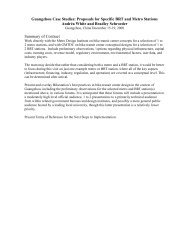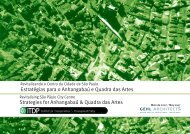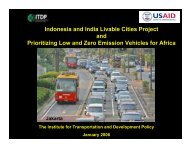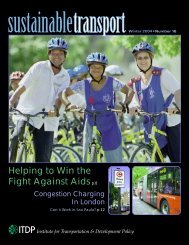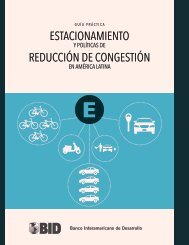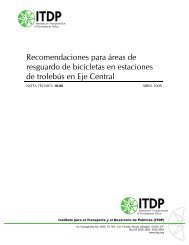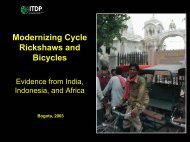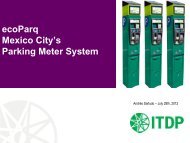Europe's Vibrant New Low Car(bon) Communities - ITDP | Institute ...
Europe's Vibrant New Low Car(bon) Communities - ITDP | Institute ...
Europe's Vibrant New Low Car(bon) Communities - ITDP | Institute ...
Create successful ePaper yourself
Turn your PDF publications into a flip-book with our unique Google optimized e-Paper software.
Greenwich Millennium Village 15<br />
<strong>Car</strong> Ownership Rates<br />
Figure 2 provides a comparison of car ownership rate per household<br />
for various segments of London. The rate for GMV falls between that<br />
of Inner London, where households are generally less car dependent,<br />
and that of Outer London, where households are typically more car<br />
dependent. The rate for GMV also falls below that for London. These<br />
figures demonstrate that many households in GMV choose to live<br />
car-free, although the car ownership rate is still not quite as low<br />
as it is in Inner London.<br />
Mode Split<br />
However, while car ownership in GMV is higher than for Inner<br />
London, car use in GMV appears to be much lower than for other<br />
areas of London, even Inner London. As seen in Figure 3, only 18%<br />
of trips made by GMV residents are by car, which is much lower than<br />
for Greenwich (44%), Inner London (29%), Outer London (51%) and<br />
London (43%). The GMV data was collected through a survey of<br />
residents conducted to fulfill the requirements for the Section 106<br />
Agreement, and included in the Travel Monitoring Study 2005 Report.<br />
Public transit use is high in GMV, particularly for trips to work.<br />
Indeed, the majority of GMV commuters (79%) travel to work by<br />
public transit. The breakdown by type of public transport shows that<br />
73% of commuters travel to work by London Underground. This is not<br />
surprising given GMV’s easy access to the Jubilee Line, connecting the<br />
development to central London, and the high cost of driving to central<br />
London due to the city’s congestion charge. Figure 4 shows that a<br />
much larger proportion of GMV residents (79%) commute to work<br />
by public transit than Inner London residents (59%), Outer London<br />
residents (38%), and overall London residents (46%). Further, the<br />
proportion of GMV residents commuting to work by car is very low.<br />
Although a small proportion of GMV residents walk or cycle to<br />
work, a much higher number walk or cycle for other trip purposes<br />
such as traveling to school and shopping (see Figure 5). Nearly onethird<br />
of those who study walk to school, however, almost a quarter<br />
drive. These results are likely due to the mix of student types; children<br />
are more likely to walk or cycle to school within the village while<br />
adults taking classes outside the district might be more likely to drive.<br />
Further, while about half of residents use their car for their main<br />
Figure 2: <strong>Car</strong> ownership of GMV as compared to surrounding area<br />
1.2<br />
0.95<br />
cars per household<br />
0.8<br />
0.4<br />
0.65<br />
0.50<br />
0.77<br />
0.0<br />
GMV<br />
(2005)<br />
Inner London<br />
(2005–06)<br />
Outer London<br />
(2005–06)<br />
London<br />
(2005–06)<br />
Rutherfords, 2005;<br />
Transport for<br />
London, 2010<br />
Figure 3: Mode split for all trips<br />
100%<br />
80%<br />
car<br />
public transit<br />
bicycle<br />
percent of trips<br />
60%<br />
40%<br />
20%<br />
walk<br />
* values shown are<br />
an average of values<br />
from 2005-2008.<br />
0%<br />
GMV<br />
(2005)<br />
Greenwich<br />
(2005–08)<br />
Inner London<br />
(2005–08)*<br />
Outer London<br />
(2005–08) *<br />
London<br />
(2005–08) *<br />
Rutherfords, 2005;<br />
Transport for<br />
London, 2009





